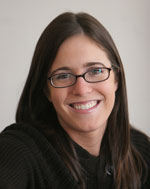Twenty Something / Christina Capecchi
Say ‘cheese’:
Looking good
to the supreme
photographer
 There are two types of people: Those who don’t take pictures and those who do. Whichever category you occupy, you probably feel some uneasiness about your position, guilty of either neglect or obsession.
There are two types of people: Those who don’t take pictures and those who do. Whichever category you occupy, you probably feel some uneasiness about your position, guilty of either neglect or obsession.
The first group muses, “I ought to take more pictures”—an obligation that’s akin to eating more cruciferous vegetables and writing prompt thank you notes.
The second group fears it goes overboard on picture-taking. This group consists disproportionately of young adults. Our ubiquitous cameras can turn the most mundane activity into a Kodak moment. Our lives are thoroughly documented on Facebook and Flickr, uploaded in the blink of an eye and the click of a button.
We perform for the camera, whipping out our trademark moves, the stances and expressions that charm a crowd and cinch a frame. We are constantly posing, turning life into one ongoing photo opportunity.
But the heavy-duty image-sculpting happens after the flash during the editing and presentation. We have unprecedented power to alter our images, to delete the unsavory shots and Photoshop the keepers. We crop strategically and sharpen the contrast, making the whites whiter and the tans tanner.
Self-perception has never been more pliable. It is easy to create a flattering portrait: life as a series of smiles cast under soft lighting. How we see ourselves depends upon the sophistication of our software. It has little to do with reality.
We must be aware of these illusions, remembering God’s direction to Samuel as he searched Bethlehem for an anointed leader: “Not as man sees does God see, because man sees the appearances but the Lord looks into the heart” (1 Sm 16:7).
The question is not the beauty of the body, as captured by the camera, but the beauty of the heart.
St. Paul calls us to shift our focus to the un-photographed inner self. “We look not to what is seen but to what is unseen,” he instructs. “For what is seen is transitory, but what is unseen is eternal” (2 Cor 4:18).
The unseen is the way we treat our neighbors when no one is watching. It is the moral code we uphold when it isn’t convenient or conventional. It is the daily effort to scrape bitterness from sticky corners in our hearts.
Let’s rise above the camera’s flash this February, saturated by the glitz of Valentine’s Day and the Academy Awards. Red roses and red carpet are far from reality.
Our aim on Earth is not to produce Hollywood glamour for the camera. We have been given a far nobler purpose. We read in Genesis this month: We are created in the image and likeness of God.
The pictures we collect may seem to hold some weight, but they are fleeting, deleted as quickly as they are snapped.
What really matters is how God sees us. How do we look through the lens of the Lord—without the benefit of the delete button and the aid of Photoshop?
That’s where we should apply our revisionary efforts, altering and adjusting each day.
Pope Benedict XVI recently reflected on the beauty of Christian living. Quoting Ephesians, he said, “Christ thus desires that we grow more beautiful each day through irreproachable moral conduct, ‘without wrinkle or defect’ ” (Eph 5:27).
So turn off the distractions: Set down the camera and log off Facebook. Stop chasing Kodak moments. Instead, chase grace, seek sacraments and pursue virtues. That kind of beauty is bigger than the camera. It can’t be contained in eight megapixels. It is only picked up by the lens of the Lord.
(Christina Capecchi is a freelance writer from Inver Grove Heights, Minn. She can be reached at christina@readchristina.com.) †
 There are two types of people: Those who don’t take pictures and those who do. Whichever category you occupy, you probably feel some uneasiness about your position, guilty of either neglect or obsession.
There are two types of people: Those who don’t take pictures and those who do. Whichever category you occupy, you probably feel some uneasiness about your position, guilty of either neglect or obsession.